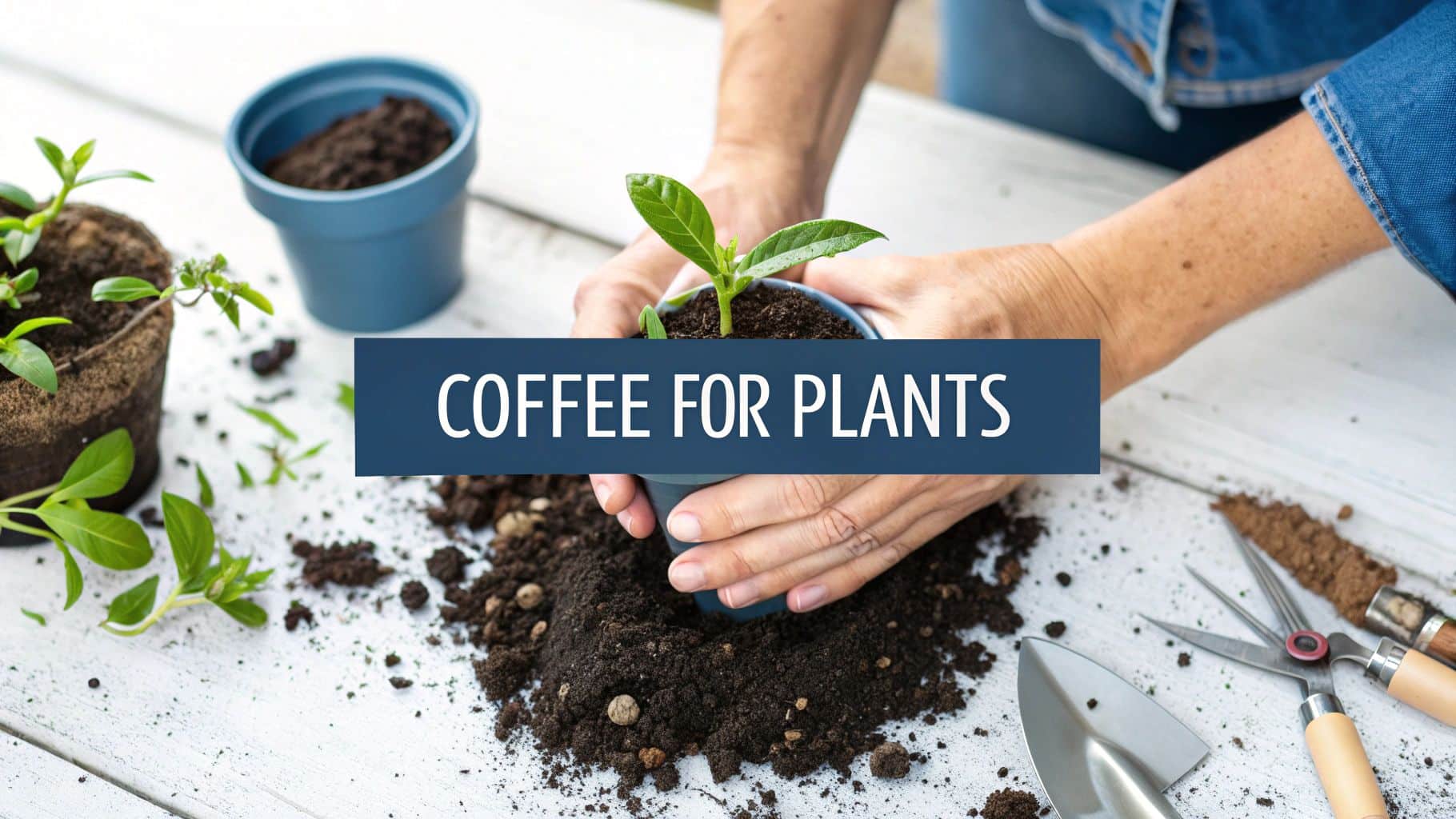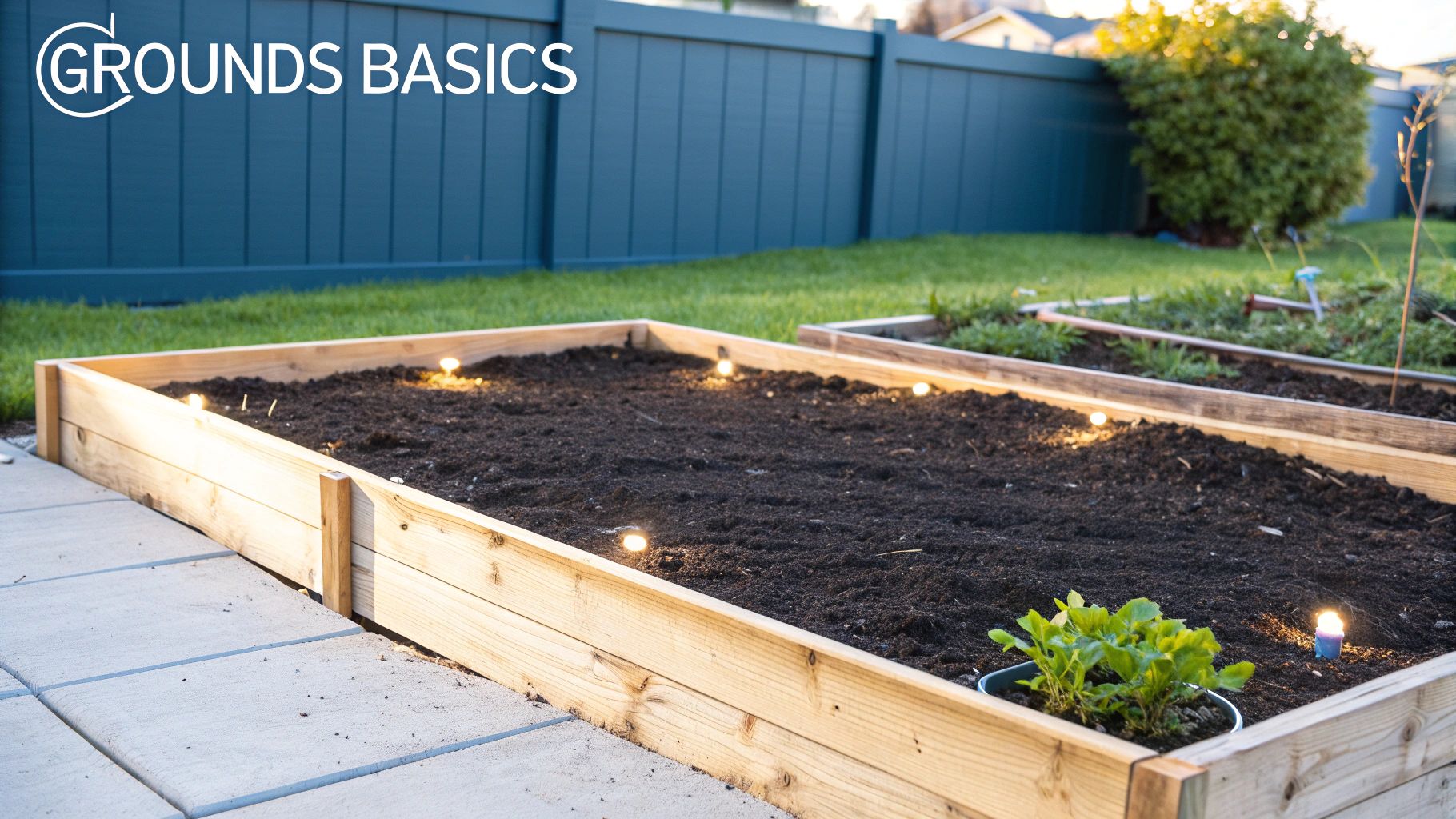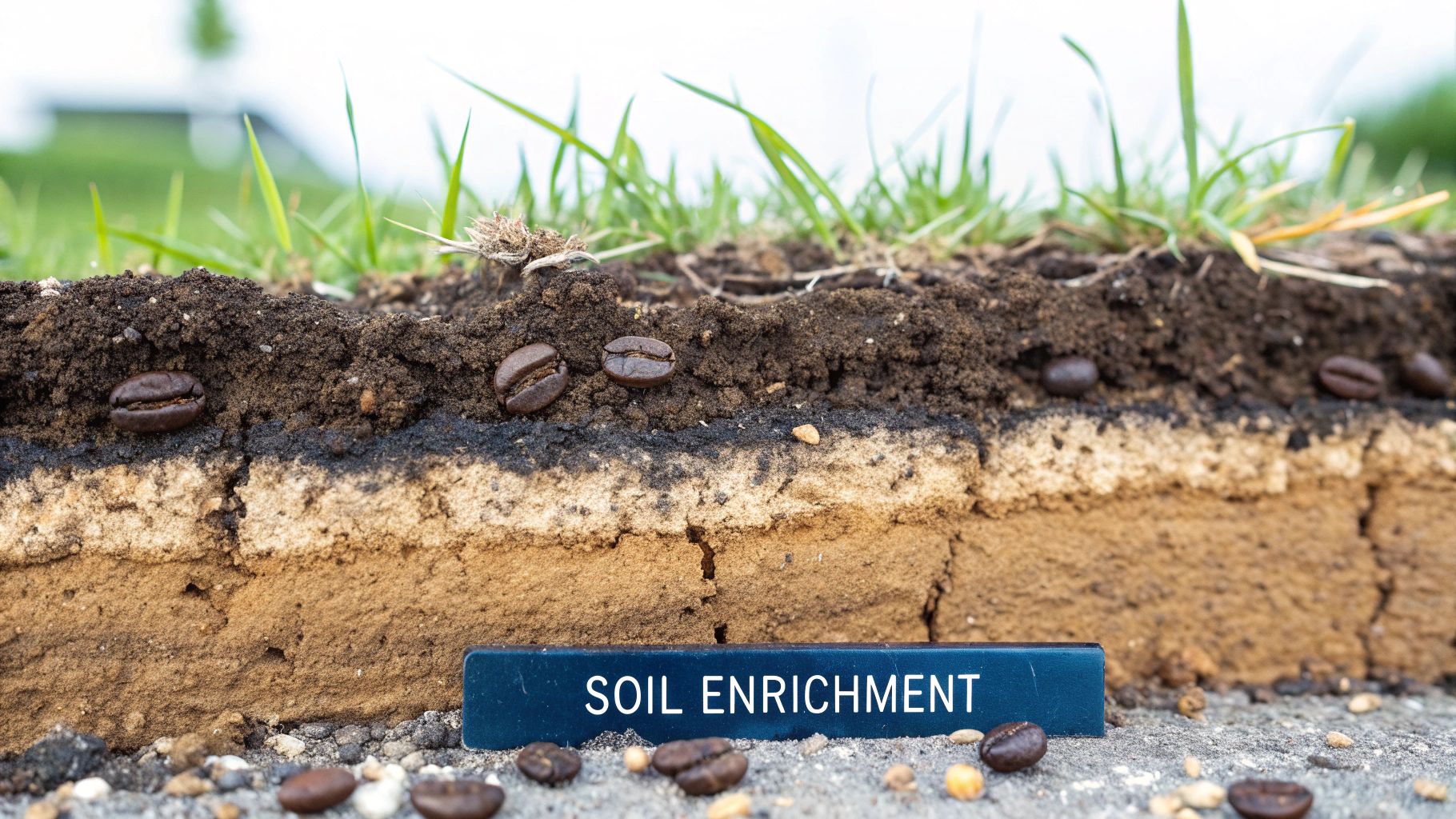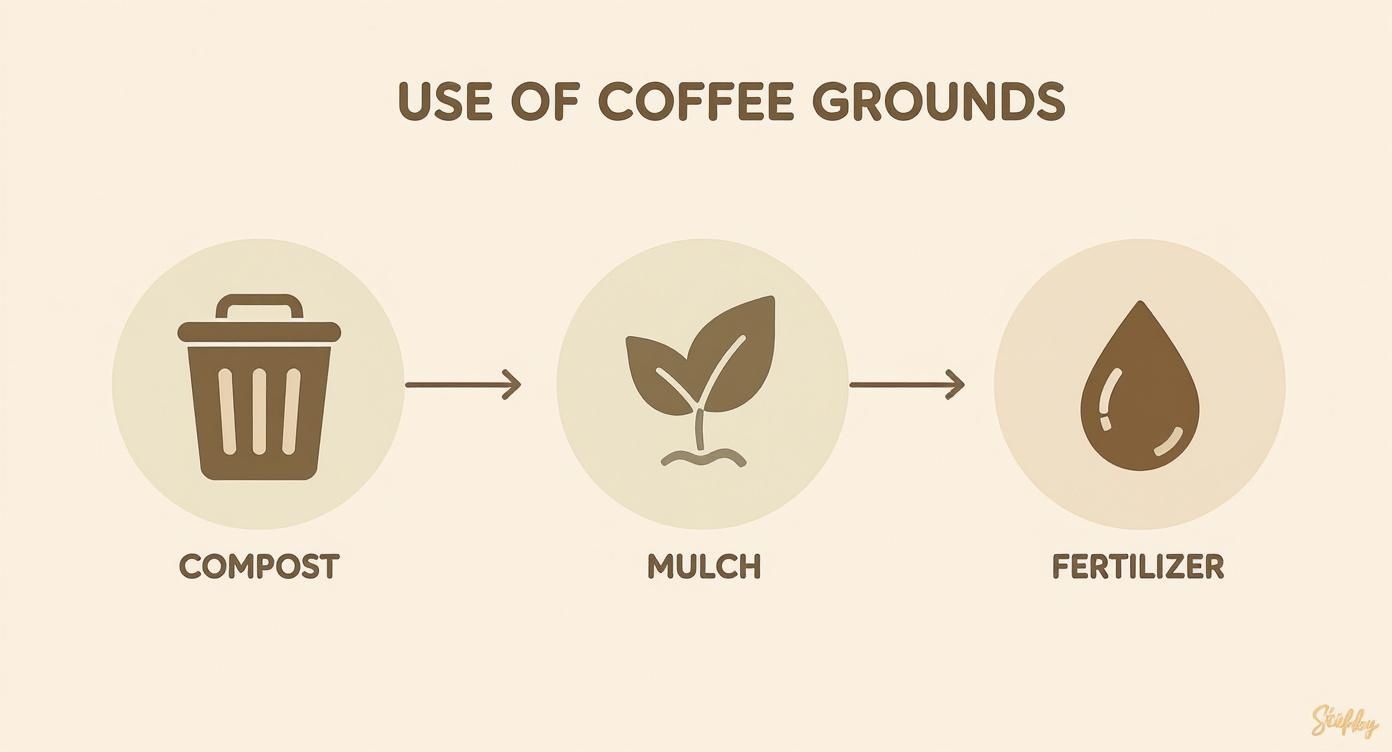Is coffee grounds good for plants: A Gardener’s Guidew

Yes, coffee grounds are good for plants—but it’s not as simple as chucking them straight from the filter onto your flowerbeds. While they're a fantastic source of nitrogen, a vital nutrient plants crave, unlocking their true potential is all about technique. Get it wrong, and you can do more harm than good.
Unlocking the Potential of Coffee Grounds
The morning ritual of brewing a pot of coffee leaves behind a brilliant resource that too many gardeners simply throw away. Those used grounds, usually destined for the bin, can be a game-changer for your garden, enriching the soil and helping your plants thrive. Success, however, hangs on knowing what you're doing.
This guide will walk you through the essentials, moving beyond a simple "yes or no" and into the practical "how and why." Once you get the hang of a few key ideas, you can turn this everyday kitchen waste into one of your garden's greatest assets.
The Foundation for Success
Before you start sprinkling coffee grounds around your prize-winning roses, it’s vital to get the basics right. The most common mistake I see gardeners make is tipping a thick layer of fresh grounds directly onto the soil. This creates a dense, water-repellent crust that can literally suffocate plant roots and even invite mould to the party.
Instead, the best methods involve a little bit of prep work. It’s worth it.
- Compost Them First: The absolute gold standard for using coffee grounds is to add them to your compost pile. Composting allows them to break down properly, neutralises their acidity, and blends their nutrients into a beautifully balanced organic matter that your garden will love.
- Know the Difference: There’s a huge distinction between fresh (unbrewed) and used (brewed) coffee grounds. Used grounds are nearly pH neutral, making them safe for most plants. Fresh grounds, on the other hand, are highly acidic and can stunt the growth of anything that doesn't love acidic soil.
- Apply with Care: If you do add them directly to the soil as an amendment, always mix them in sparingly. Never, ever leave them as a thick top layer.
The key is moderation. In the UK, coffee grounds are widely recognised as a fantastic soil improver, but experts agree they shouldn't make up more than 20% of your total compost volume. Any more than that, and you risk creating a mix that can become toxic to your plants. You can discover more about using coffee grounds safely in your UK garden.
By sticking to these core principles—always choosing composting over direct application and sticking to used grounds—you're setting yourself up for success. This approach ensures you’re actually helping, not harming, your plants, turning a simple byproduct of your daily routine into a genuine garden asset.
Using Coffee Grounds: A Quick Comparison
To make things even clearer, let's break down the main upsides and potential pitfalls. Thinking about these points before you start will help you get the best results and avoid common mistakes.
| Benefit | Risk |
|---|---|
| Rich in Nitrogen: Provides a key nutrient for lush, green leafy growth. | Can Create a Barrier: If applied too thickly, it forms a crust that blocks water and air. |
| Improves Soil Structure: Helps with drainage and aeration when mixed into soil or compost. | Potential Acidity Issues: Fresh (unbrewed) grounds are highly acidic and can harm many plants. |
| Attracts Earthworms: Worms love coffee grounds and help improve soil health naturally. | Can Encourage Mould: A thick, damp layer of grounds is a perfect breeding ground for mould. |
| Deters Some Pests: The smell and texture can help keep slugs and snails at bay. | Compost Imbalance: Using too much (over 20% of volume) can disrupt the composting process. |
Ultimately, the benefits far outweigh the risks as long as you're sensible. By composting them first and using them in moderation, you harness all the good stuff while sidestepping any potential problems.
How Coffee Grounds Actually Affect Your Soil
To really get to grips with whether coffee grounds are good for plants, we need to look beneath the surface at what they’re actually doing to the soil. It’s best to think of them not as a quick fix, but as a long-term investment in your garden’s health. Their true value is hidden in their chemical makeup and how they interact with the complex world underground.
The most talked-about ingredient in coffee grounds is nitrogen, which is absolutely essential for lush, leafy growth. Gardeners often sort their compost materials into 'greens' (rich in nitrogen) and 'browns' (rich in carbon). Despite their dark colour, used coffee grounds are firmly in the 'green' camp, offering a slow-release source of this vital nutrient.
This slow-release action is what makes them so brilliant. Unlike fast-acting synthetic fertilisers that can shock plants with a sudden nutrient blast, the nitrogen in coffee grounds becomes available bit by bit. Soil microorganisms have to break them down first, which feeds your entire soil ecosystem and, in turn, your plants.
Debunking The Acidity Myth
A common worry I hear from gardeners is that coffee grounds will make their soil far too acidic. While that’s a fair concern for fresh, unbrewed coffee, the brewing process changes everything.
Once hot water has passed through them, used coffee grounds are surprisingly close to pH neutral, typically landing somewhere between 6.5 and 6.8. This means they’re perfectly safe for the vast majority of garden plants and won’t throw your soil's pH out of whack when used correctly.
More Than Just Nutrients: Transforming Soil Structure
The real magic of coffee grounds goes beyond their nutrient content; it's their ability to completely change the physical structure of your soil.
Imagine a dry, compacted sponge—water just runs straight off it. Now, picture a light, airy one that soaks everything up. That’s what coffee grounds help your soil become.
Their fine, gritty texture is fantastic for breaking up heavy clay soils, preventing them from clumping together. This improves drainage and, crucially, allows plant roots to breathe. In sandy soils, they do the exact opposite, helping to bind loose particles together to improve water retention. This dual-action benefit makes them an incredibly versatile soil amendment.
Building Healthier Soil From The Ground Up
Introducing coffee grounds does more than just feed your plants; it invigorates the entire soil food web. Earthworms, in particular, seem to love them. Their tunnelling is one of nature’s best forms of soil aeration, and encouraging them is always a win for the garden.
Typically, spent coffee grounds contain about 2% nitrogen by weight. While this is a decent amount, it’s important to apply them properly. Most UK gardeners find that a thin layer, around 1.27 cm (half an inch), worked gently into the top layer of soil is the sweet spot. This avoids any risk of it compacting and stunting plant growth.
Of course, understanding how any soil amendment works starts with knowing the fundamentals of soil health. Exploring some essential tips for preparing garden soil will give you a great foundation. By adding organic matter like coffee grounds, you’re not just providing a snack for your plants; you’re building a more resilient, fertile, and well-structured base for everything you want to grow. This is how you turn a simple kitchen leftover into a powerhouse for a thriving garden.
The Smartest Ways to Use Coffee Grounds
Now that we've dug into the science of what coffee grounds bring to the soil, it's time to put them to work. But hold on a second – just scattering them across your garden isn't the best plan. With a few simple, smart techniques, you can make sure your plants get all the goodness without any of the potential drama.
Across the UK, gardeners are increasingly catching on to using coffee grounds as a fertiliser and soil improver, which fits perfectly with wider sustainability trends. Coffee shops and home brewers produce mountains of spent grounds, and when they're composted, they significantly boost the soil's nitrogen—a vital nutrient for lush plant growth.
Composting: The Gold Standard Method
Without a doubt, adding your used coffee grounds to a compost bin is the safest and most effective way to harness their power. Composting allows them to break down completely, weaving their nutrients into a rich, balanced organic matter that your garden will absolutely love.
It’s a really straightforward process:
- Collect Your Grounds: After your morning brew, simply pop the used grounds and the paper filter straight into your kitchen compost caddy.
- Add to the Main Bin: Tip the contents into your main compost bin or pile outside.
- Balance with 'Browns': This is the key part. Coffee grounds are a 'green' material, rich in nitrogen. For every bucket of grounds and other green waste (like fresh grass clippings), you'll want to add roughly two buckets of 'brown' material. Think dried leaves, shredded cardboard, or torn-up newspaper.
- Turn and Wait: Give your compost pile a good mix every so often to get some air in there. Over time, everything will break down into a dark, crumbly, and nutrient-rich compost, ready to be spread on your garden.
For a deeper dive into getting this process just right, check out our complete guide on composting coffee grounds. This method takes out all the guesswork and delivers fantastic results every time.
Using Grounds as a Soil Amendment or Mulch
If you don’t have a compost bin, you can still use grounds directly in your garden, but a bit of care is needed. The secret is to apply them very thinly and always mix them into the soil.
Never, ever apply a thick layer of coffee grounds directly onto the soil surface. It creates a dense, compacted mat that acts like a barrier, blocking water and air from reaching plant roots. This can quickly lead to mould and suffocate your plants.
Instead, sprinkle a very light dusting—no more than a centimetre deep—around your established, nitrogen-loving plants. Then, gently work it into the top few centimetres of soil with a hand fork or rake. This light-touch approach improves the soil structure without creating that problematic crust.
Brewing a Liquid Fertiliser
For a quick nutrient hit, especially for potted plants or hungry vegetables, you can brew up a "coffee tea" liquid fertiliser. This weak brew provides a gentle dose of nitrogen and other micronutrients that plants can absorb almost instantly.
Here's how to make it:
- Add two cups of used coffee grounds to a 20-litre bucket of water.
- Let the mixture steep overnight, or for up to 24 hours.
- Strain the liquid to remove the grounds (which can then go in the compost).
- Use the resulting "tea" to water your plants right at their base.
This is a brilliant way to feed leafy greens and other demanding plants during their main growing season. Of course, coffee grounds are just one tool in the gardener's shed. Understanding a wider range of options is always helpful, and you can learn more about using a natural fertilizer for grass to expand your green-fingered knowledge.
Which Plants Love Coffee Grounds and Which to Avoid
Knowing whether coffee grounds are good for your plants almost always comes down to one crucial thing: the plant itself. Just as some of us prefer tea over coffee, certain plants absolutely thrive with this amendment, while others will react poorly. Think of it as playing matchmaker for your garden, pairing the gentle nitrogen boost from coffee grounds with the plants that will appreciate it the most.
This handy infographic breaks down the main ways you can turn coffee waste into a valuable resource for your garden, from composting right through to mulching.
As you can see, composting, mulching, or even making a liquid fertiliser are by far the safest and most effective ways to use your leftover grounds.
To make it even clearer, let's get into the specifics of which plants are a good match and which you should steer clear of.
Plant Compatibility with Coffee Grounds
Here’s a quick guide to help you figure out which common garden plants will thank you for a sprinkle of coffee grounds and which might hold a grudge.
| Plant Type | Loves Coffee Grounds (and Why) | Dislikes Coffee Grounds (and Why) |
|---|---|---|
| Root Veg | Carrots, radishes, and parsnips adore how grounds loosen heavy soil, giving their roots room to expand. | — |
| Leafy Greens | Cabbage, kale, and spinach gobble up the slow-release nitrogen to produce big, healthy leaves. | — |
| Acid Lovers | Classic acid-loving plants like azaleas, rhododendrons, hydrangeas, and blueberries flourish with the slight acidity. | — |
| Roses | Roses appreciate the gentle nutrient boost and improved soil texture, leading to stronger growth and more vibrant blooms. | — |
| Herbs | — | Mediterranean herbs like lavender, rosemary, and thyme need alkaline, well-drained soil. The acidity and moisture retention from grounds is the opposite of what they crave. |
| Tomatoes | — | Some evidence suggests compounds in coffee can actually inhibit the growth of tomatoes. It's best to be cautious. |
| Seedlings | — | Young, delicate seedlings are easily overwhelmed. The nutrient concentration and potential for mould can be fatal to them. |
This table should give you a solid starting point for deciding where those used grounds can do the most good. Now, let's dive a bit deeper.
Plants That Thrive with Coffee Grounds
The plants that benefit most from a light helping of coffee grounds are usually the ones that crave nitrogen and are perfectly happy in slightly acidic to neutral soil. These are often the heavy feeders in your garden, the ones that need plenty of fuel to produce lush foliage, brilliant flowers, or a bumper harvest.
Plants that generally respond well include:
- Root Vegetables: Carrots, radishes, and parsnips really appreciate how grounds help loosen up dense soil, allowing their roots to grow straight and strong.
- Leafy Greens: Think cabbage, kale, and spinach. They use that slow-release nitrogen to power the growth of vigorous, healthy leaves.
- Acid-Loving Plants: Azaleas, rhododendrons, hydrangeas, and blueberries are the poster children for this group. They thrive in acidic conditions, making coffee grounds a fantastic soil amendment for them.
- Roses: Many gardeners across the UK swear by adding coffee grounds to the soil around their roses, crediting them for stronger growth and more impressive blooms.
For these plants, the grounds offer a gentle nutrient lift and a welcome improvement to soil structure.
Plants to Keep Coffee Grounds Away From
On the flip side, some plants just don’t get on with coffee grounds. Applying them around the wrong species can lead to stunted growth or unhappy plants, undoing all your hard work. This is especially true for plants that have evolved to prefer alkaline, or "sweet," soil.
It’s best to avoid using coffee grounds anywhere near these plants:
- Delicate Seedlings: Young plants are incredibly sensitive. The concentrated nutrients and potential for fungal growth from fresh grounds can easily overwhelm and kill them.
- Alkaline-Loving Herbs: Many popular Mediterranean herbs, such as lavender, rosemary, and thyme, prefer gritty, well-drained, alkaline soil. The slight acidity and moisture retention from grounds is the exact opposite of what they need to thrive.
- Tomatoes and Clovers: Some studies suggest that certain compounds in coffee can actually inhibit the growth of specific plants, including tomatoes and clovers. It's always better to err on the side of caution with these.
The golden rule is simple: if a plant prefers alkaline soil or is in a fragile, early stage of growth, keep the coffee grounds away. Sticking to well-rotted compost is always the safest bet for these more sensitive garden inhabitants.
Common Mistakes to Avoid When Using Coffee Grounds
Coffee grounds can be a fantastic, free resource for your garden, but a few simple missteps can turn this brilliant idea into a horticultural headache. Knowing what not to do is just as important as knowing what works. By sidestepping these common pitfalls, you can make sure your coffee habit only helps, not harms, your plants.
The most frequent mistake I see gardeners make is applying the grounds far too thickly. It’s tempting to just dump the entire contents of your cafetière at the base of a plant, but this creates a dense, compacted layer on the soil surface.
This thick crust does two very damaging things. First, it acts like a barrier, preventing water and air from getting down to the plant’s roots where they're needed most. Second, this damp, tightly packed layer is the perfect breeding ground for mould, which can introduce diseases and put your plants under stress.
Avoiding Fresh Grounds and Overloading Seedlings
Another critical error is using fresh, unbrewed coffee grounds directly in the garden. Unlike their used counterparts, which are nearly pH neutral, fresh grounds are highly acidic. This acidity can severely damage or even kill plants that don't thrive in acidic conditions.
What's more, the caffeine and other compounds in fresh grounds can actively stop other plants from growing nearby—a phenomenon known as allelopathy. It's nature's way of reducing competition, but it's the last thing you want happening in your flowerbeds. Stick to brewed grounds only.
A crucial rule to remember: keep coffee grounds well away from young, delicate plants. Seedlings have incredibly sensitive root systems that are easily overwhelmed by the nutrient concentration and sheer physical density of coffee grounds. Adding them near seedlings can stunt their growth or even prove fatal.
To keep your garden happy, just follow these simple guidelines:
- Go Thin or Go Home: If you’re putting grounds directly on the soil, use only a very thin layer (less than 1.5 cm) and gently work it into the topsoil.
- Compost is King: The safest and most beneficial method is always to add your grounds to the compost bin. There, they can break down safely and become part of a balanced soil amendment.
- Protect the Young: Never use grounds around seedlings or very young plants. Wait until they are well-established and robust before introducing grounds nearby.
The Misconception of a Quick Fix
It’s easy to think of coffee grounds as a quick-acting fertiliser, but their real value lies in long-term soil improvement. They are not a substitute for a balanced plant food. The nitrogen they contain is released slowly as microorganisms break them down, a process that improves soil structure and health over many months, not days.
Expecting an immediate, dramatic boost in growth is a common misunderstanding. Instead, think of them as a soil conditioner that contributes to a healthier garden ecosystem in the long run. By using them thoughtfully and steering clear of these common mistakes, you can turn your daily coffee ritual into a truly sustainable practice for a thriving garden.
Your Coffee Grounds Gardening Questions Answered
Even with the best advice, a few practical questions always pop up once you get your hands dirty. Getting straight answers can build your confidence and help you make the most of this brilliant, free resource. Let's tackle some of the most common queries to clear up any lingering doubts.
Think of this section as your go-to guide for the hands-on side of using coffee grounds in the garden.
Can I Put Coffee Grounds Directly on My Plants?
As tempting as it is to just sprinkle them around, it's generally best not to put large amounts of coffee grounds directly onto your plants. While a very thin layer (less than 1.5 cm) mixed into the soil might be fine for mature, nitrogen-hungry plants, the safest and most effective method is to compost them first.
Piling them on thick can create a dense, waterproof crust on the soil surface. This barrier stops moisture and air from getting to the roots and can sometimes encourage mould. Composting breaks the grounds down properly, neutralises their slight acidity, and turns them into a balanced, nutrient-rich soil amendment that’s much friendlier to everything in your garden.
Do Coffee Grounds Really Deter Slugs and Snails?
There's a lot of anecdotal evidence out there suggesting that coffee grounds can help ward off slugs and snails. The theory makes sense: the gritty, abrasive texture is irritating to their soft bodies, and any leftover caffeine is toxic to them, so they’re more likely to find an easier meal elsewhere.
To give it a go, create a ring of dry, used grounds around the base of vulnerable plants like hostas or lettuces. The catch? Its effectiveness plummets as soon as the grounds get wet from rain or watering. It's definitely not a foolproof solution, but it can be a useful part of a wider pest management strategy.
Think of it as a temporary deterrent rather than a permanent barrier. You'll need to reapply the dry grounds after it rains to maintain any effect they might have.
How Often Should I Add Coffee Grounds to My Garden?
Moderation is the golden rule here. Because coffee grounds release their nutrients slowly, a little goes a long way over the growing season.
- In Compost: Coffee grounds shouldn't make up more than 20-25% of your total compost pile. The key is balance, so always mix them with plenty of 'brown' materials like dried leaves, shredded cardboard, or straw.
- Directly on Soil: If you decide to add them straight to the soil as a light mulch or amendment, do it sparingly. Sprinkling them around heavy-feeding plants like roses or leafy greens once or twice per season is usually more than enough.
Applying too much can throw your soil's nutrient balance out of whack and lead to a compacted, clumpy structure. The best approach is always to watch how your plants respond and adjust as you go.
Are Coffee Filters and Tea Bags Also Good for the Garden?
Yes, absolutely! Both coffee filters and most tea bags are fantastic additions to your compost heap. Paper coffee filters count as a 'brown' (carbon-rich) material, which helps balance out the nitrogen-rich 'green' grounds they hold.
Most tea bags are compostable too, but it’s crucial to check for any plastic mesh, staples, or synthetic strings before you toss them in. Tea leaves, just like coffee grounds, are a 'green' material that adds valuable nitrogen. Both contribute organic matter that helps build the healthy, fertile soil every gardener dreams of.
At Seven Sisters Coffee Co, we’re passionate about every part of the coffee journey—from the bean, to the brew, and right through to the garden. Our commitment to sustainability means helping you make the most of every single cup. Explore our exceptional range of single-origin and blended coffees, roasted with care in an oxygen-free environment to unlock the richest flavours. Find your perfect brew and start your sustainable gardening journey today by visiting https://sevensisterscoffee.co.uk.




